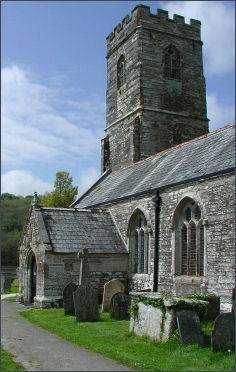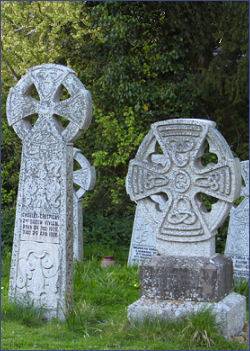St. Winnow
OS grid ref:- SX 1157
 The pretty hamlet St Winnow, known in the Cornish language as Sen Gwynnow may be connected with either Saint Winnoc or Saint Winwaloe. The picturesque hamlet is situated on the east bank of the River Fowey to the south of Lostwithiel. Some scenes from the BBC TV series Poldark were filmed there.
The pretty hamlet St Winnow, known in the Cornish language as Sen Gwynnow may be connected with either Saint Winnoc or Saint Winwaloe. The picturesque hamlet is situated on the east bank of the River Fowey to the south of Lostwithiel. Some scenes from the BBC TV series Poldark were filmed there.
St Winnow was mentioned in the Domesday Book of 1086 where it is referred to as San Winnuc. In 1644-5, some 90 persons of the parish perished of the plague, this occurred during the English Civil War but only four of the dead were soldiers.
The village church is of Norman foundation but the present building is almost entirely fifteenth century in date. There is some interesting stained glass in the building
 The church stands at the riverside, next to a quay and has spectacular views across the estuary. It probably occupies the site of the seventh century oratory of St Winnoc. A stone church was constructed in the twelfth century and traces of the Norman stonework have survived on the north side. The transept arch was reconstructed in the thirteenth century. In around 1465 the south wall was demolished and the south aisle, arcade and roofs built. The chancel was restored by J. H. Seddon in the nineteenth century, retaining the sixteenth century east window. There is stained glass of circa 1500 in the east windows of the chancel and the south aisle.
The church stands at the riverside, next to a quay and has spectacular views across the estuary. It probably occupies the site of the seventh century oratory of St Winnoc. A stone church was constructed in the twelfth century and traces of the Norman stonework have survived on the north side. The transept arch was reconstructed in the thirteenth century. In around 1465 the south wall was demolished and the south aisle, arcade and roofs built. The chancel was restored by J. H. Seddon in the nineteenth century, retaining the sixteenth century east window. There is stained glass of circa 1500 in the east windows of the chancel and the south aisle.
The rood screen, which is carved with leaves and flowers, was restored by Violet Pinwell in 1907. Rood screens are rare in Cornwall, and the one at St. Winnow is one of the finest. The granite font, carved with angels bearing shields,dates back to the fourteenth century. The pulpit is of c.1600 and richly carved. There are also superb carved bench ends of various dates from 1485 to 1630, some of the carving subjects are the typical Biblical scenes, but others are more unusual, like a man in a Cornish kilt drinking cider, a St Catherine's Wheel, and a ship in a storm. In the west tower arch a highly decorated painted letter from Charles I to the people of Cornwall is displayed. The monuments include one in slate to William Sawle, d. 1651. A burial plot with Celtic-style headstones for the Vivian family occupies the north-west corner of the churchyard.
The chapel of St Nectan, which stands 2 1/2 miles north-east from the Parish church, dates to the thirteenth and fifteenth centuries but the north aisle was added in 1825. The tower lost its upper stages during the Civil War (1644) and the six bells are said to have been melted down to furnish war materials